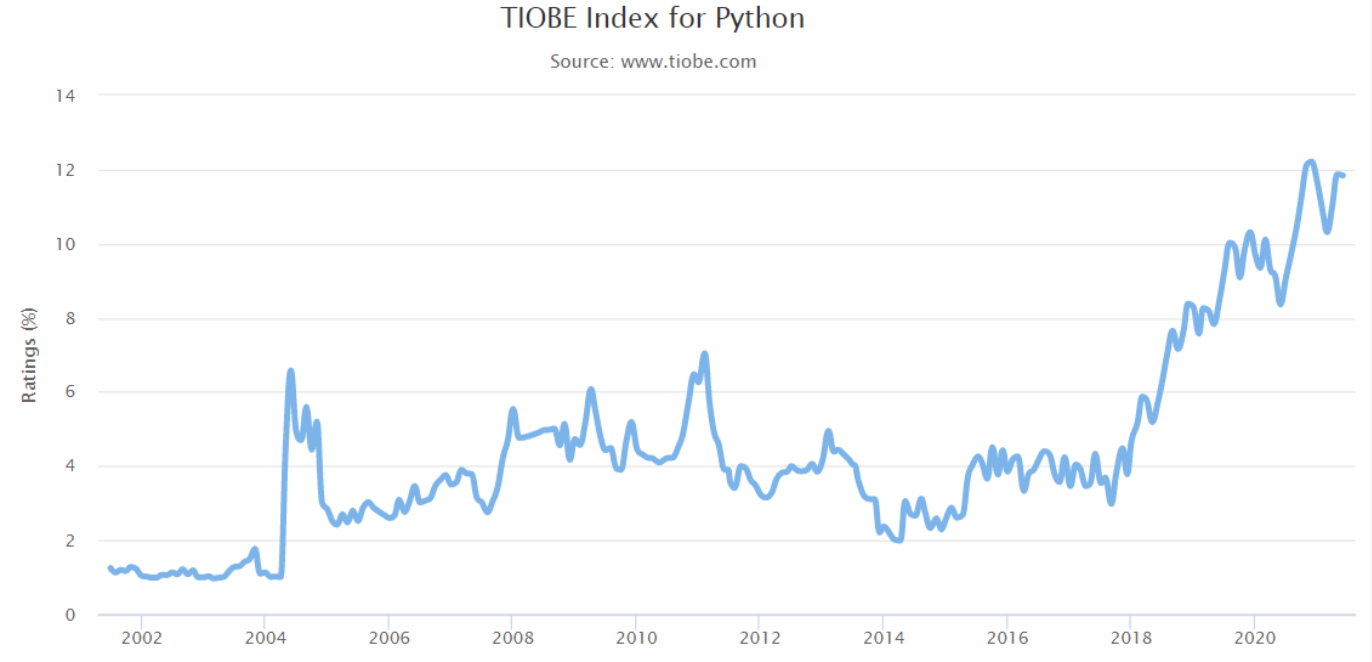What is Python used for? Over the last few years, Python has become increasingly popular. And in 2021, it was the top programming language that employers sought, with over 70,000 job descriptions asking for it. It’s a language that can handle complicated tasks, but has a simple syntax and is easy enough for new developers to learn. Clearly, it’s a language worth having in your toolkit. But once you know the basics, what exactly can you create?
Python is extremely popular and versatile
First released in 1991, Python is a programming language that’s been through a few versions. The latest version, Python 3, was released in 2008. Since then, it has consistently been one of the top programming languages in the world. One of Python’s core traits is that it’s designed to be modular. The standard library is particularly comprehensive, but it’s also easy to find and add new libraries to fit whatever task you’re attempting. It’s deliberately simple and easy to read. It embraces a philosophy that when coding in Python “there should be one – and preferably only one – obvious way to do it.”
 Python has continued to grow in popularity since it launched. As of 2021, the TIOBE Index ranks it second in the world.
Python has continued to grow in popularity since it launched. As of 2021, the TIOBE Index ranks it second in the world.
It has nearly 300,000 packages
While you can use Python’s standard library for quite a lot of tasks, from creating graphical user interfaces to complicated mathematics, there are also over 290,000 packages you can plug in from the Python Package Index. These include libraries on using databases, processing images, machine learning, networking computers, and processing text. This is Python’s biggest strength. And it’s one key reason it’s used so widely.
Most large organizations use Python
Amazon. CERN. Facebook. Google. Instagram. NASA. Reddit. Spotify. Wikipedia. Yahoo. All of them use Python in some way or another, for a range of different tasks. Wherever you end up working, it’s likely that some elements will use Python. It might be for a single function, like your web server. Or it could be the main application you’re developing.
 Source: TIOBE. Python is chomping at the heels of C and could very well surpass it.
Source: TIOBE. Python is chomping at the heels of C and could very well surpass it.
So what can you actually do with Python?
Develop software or mobile apps
This shouldn’t be all that surprising. As with most languages, Python can create computer software and mobile applications. Often these are for utility. But with the right libraries, there’s really no limit to what you can create. For example, MakeHuman is a powerful 3D modeling software, programmed in Python. According to AppDeveloper Magazine, Python is particularly popular for creating applications in finance, whether that’s to help retail banks record transactions or insurance companies to predict payouts.
Create web applications
Because Python is so ubiquitous, it’s common to find plugins and widgets creating in the language. If you want to customize these – or integrate the code into your own website in another way – it’s particularly important to understand it. Most of these applications are on the backend. For example, Plone is an open-source content management system. It lets users handle what content is on their website and easily add and change it. But Python can also be used to create front-end applications hosted online, like widgets. Or even frameworks to handle the server-side processing.
Analyze and visualize data
A common way to use Python is for scanning through databases, or scraping the web, and then organizing that data into an easier format to read. Python has in-built graphical libraries as well as good capabilities for working with databases. This makes it very popular for analyzing and then turning that data into something more visual. For example, heat maps, histograms or even just a simple bar chart. The fact that Python can work well with complex datasets and turn it into something understandable, but also be able to deal with difficult mathematics, is possibly why it’s so popular in financial industries.
Run machine learning and artificial intelligence
Large libraries of code, especially around natural language processing, lend themselves well for researchers looking into artificial intelligence. Developers can easily run the program without needing to compile it into machine code beforehand, and it can be much easier to host the program on a virtual machine. This lets researchers create neural nets, process vast amounts of data, and let the code teach itself. All with relative ease, compared to other languages. In fact, Python is typically the preferred language when looking into artificial intelligence and machine learning.
Make a game
Lastly, it’s worth mentioning that Python is often used in game development, too. While it’s rare that a game will be exclusively programmed in Python, it can be used for lots of different aspects. Battlefield 2, for example, uses Python to keep the scores and balanced teams. While Civilization 4 uses Python for its logic processing, including the AI.
Python is in demand
Whatever metric you use, it’s clear that Python is one of the most popular languages on the planet. Even when it isn’t the main language for a project, there’s likely some Python touching the project somewhere along the stack.
If you’d like to add Python to the languages in your arsenal, check out our bootcamp. We teach three full stacks in just three months. Read the syllabus for more information.

